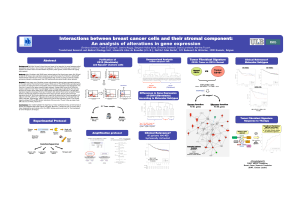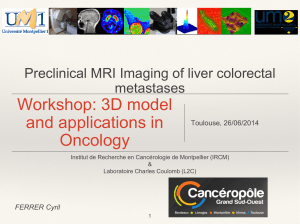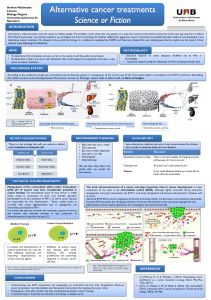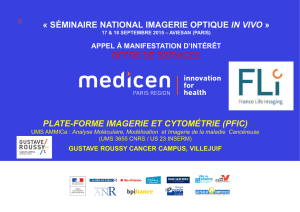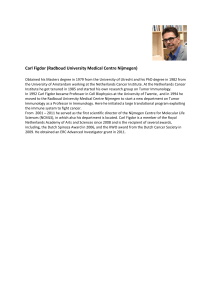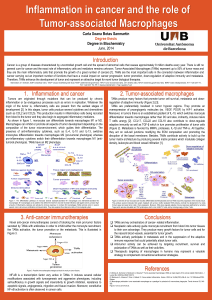Poster Session A
publicité
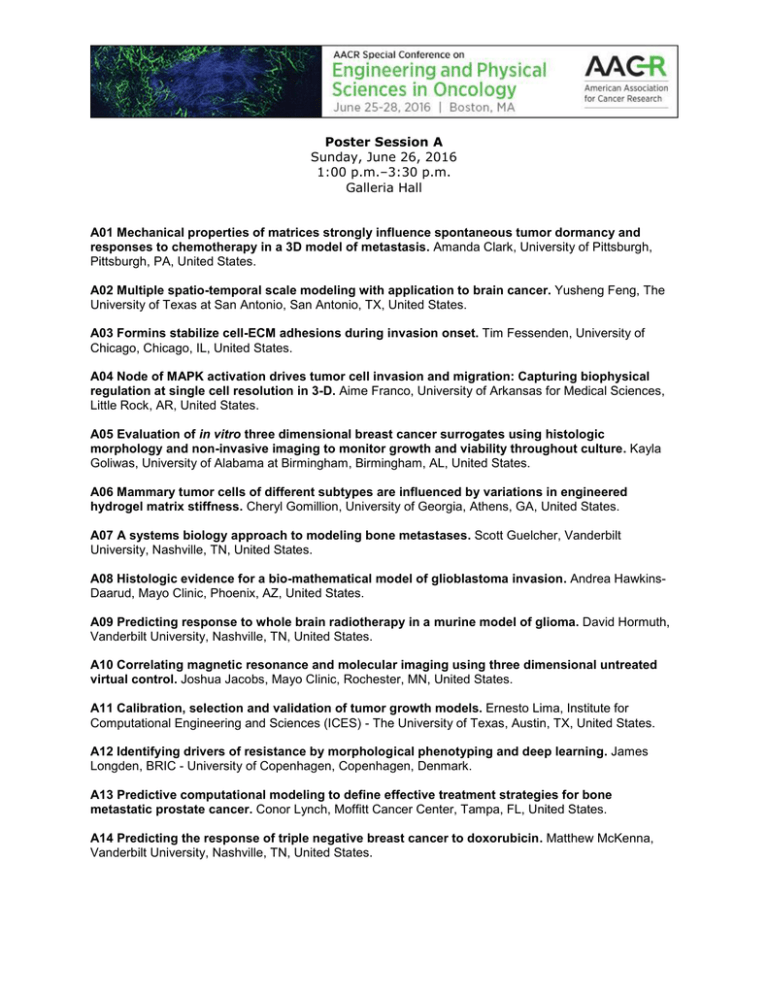
Poster Session A Sunday, June 26, 2016 1:00 p.m.–3:30 p.m. Galleria Hall A01 Mechanical properties of matrices strongly influence spontaneous tumor dormancy and responses to chemotherapy in a 3D model of metastasis. Amanda Clark, University of Pittsburgh, Pittsburgh, PA, United States. A02 Multiple spatio-temporal scale modeling with application to brain cancer. Yusheng Feng, The University of Texas at San Antonio, San Antonio, TX, United States. A03 Formins stabilize cell-ECM adhesions during invasion onset. Tim Fessenden, University of Chicago, Chicago, IL, United States. A04 Node of MAPK activation drives tumor cell invasion and migration: Capturing biophysical regulation at single cell resolution in 3-D. Aime Franco, University of Arkansas for Medical Sciences, Little Rock, AR, United States. A05 Evaluation of in vitro three dimensional breast cancer surrogates using histologic morphology and non-invasive imaging to monitor growth and viability throughout culture. Kayla Goliwas, University of Alabama at Birmingham, Birmingham, AL, United States. A06 Mammary tumor cells of different subtypes are influenced by variations in engineered hydrogel matrix stiffness. Cheryl Gomillion, University of Georgia, Athens, GA, United States. A07 A systems biology approach to modeling bone metastases. Scott Guelcher, Vanderbilt University, Nashville, TN, United States. A08 Histologic evidence for a bio-mathematical model of glioblastoma invasion. Andrea HawkinsDaarud, Mayo Clinic, Phoenix, AZ, United States. A09 Predicting response to whole brain radiotherapy in a murine model of glioma. David Hormuth, Vanderbilt University, Nashville, TN, United States. A10 Correlating magnetic resonance and molecular imaging using three dimensional untreated virtual control. Joshua Jacobs, Mayo Clinic, Rochester, MN, United States. A11 Calibration, selection and validation of tumor growth models. Ernesto Lima, Institute for Computational Engineering and Sciences (ICES) - The University of Texas, Austin, TX, United States. A12 Identifying drivers of resistance by morphological phenotyping and deep learning. James Longden, BRIC - University of Copenhagen, Copenhagen, Denmark. A13 Predictive computational modeling to define effective treatment strategies for bone metastatic prostate cancer. Conor Lynch, Moffitt Cancer Center, Tampa, FL, United States. A14 Predicting the response of triple negative breast cancer to doxorubicin. Matthew McKenna, Vanderbilt University, Nashville, TN, United States. Poster Session A Sunday, June 26, 2016 1:00 p.m.–3:30 p.m. Galleria Hall A15 Development of an in vitro 3D vessel-spheroid model for investigating cancer metastasis. Adam Munoz, Cornell University, Ithaca, NY, United States. A16 Using 3D tumor simulations to determine optimal therapeutic conditions for the cold atmospheric plasma device. William Murphy, The George Washington University, Washington, DC, United States. A17 Genomic analysis and simulation for understanding heterogenous cancer evolution. Atsushi Niida, The University of Tokyo, Institute of Medical Science, Tokyo, Japan. A18 A novel 3D co-culture system for the study of adipocyte and extracellular matrix influences on the breast cancer phenotype. Nikitha Pallegar, Memorial University of Newfoundland, St. Johns, NL, Canada. A19 Chemotherapeutic treatment enriches for cancer stem cell content in breast cancer spheroids. Daniel Reynolds, Boston University, Boston, MA, United States. A20 Use of cell-free plasma DNA for dynamic monitoring of response to cytotoxic chemotherapy. Daniel Ruderman, USC Keck School of Medicine, Los Angeles, CA, United States. A21 3D tumor models in bioreactors recapitulate microenvironment and disease progression. Vitor E Santo, iBET; ITQB-NOVA, Oeiras, Portugal. A22 A window into 3D culture: A multi-modal imaging compatible bioreactor for developing tumor growth models. Abigail Searfoss, Vanderbilt University, Nashville, TN, United States. A23 A finite element model of perfusion and diffusion within tumors based on dynamic contrast enhanced magnetic resonance imaging. Ryan Woodall, The University of Texas at Austin, Austin, TX, United States. A24 ZAP-70 and SYK regulation in the B cell receptor pathway in chronic lymphocytic leukemia. Maria Frushicheva, Massachusetts Institute of Technology, Cambridge, MA, United States. A25 Systems biology approach to delineating DNA damage response and R-loop dependencies in Ewing sarcoma. Aparna Gorthi, University of Texas Health Science Center at San Antonio, San Antonio, TX, United States. A26 Shotgun lipidomics analysis of temozolomide-treated glioblastoma. Soo Jung Ha, Purdue University, West Lafayette, IN, United States. A27 A linked data approach to discover HPV oncoprotiens and RB1 induced mutation associations for the retinoblastoma research. Alokkumar Jha, Insight Centre for Data Analytics, National University of Ireland Galway, Galway, Ireland. A28 Imaged-based computational predictions of imaging agent efficacy in pancreatic tumors expressing TLR2. Aleksandra Karolak, Moffitt Cancer Center, Tampa, FL, United States. Poster Session A Sunday, June 26, 2016 1:00 p.m.–3:30 p.m. Galleria Hall A29 Heterogeneity of androgen receptor dynamics and drug response in prostate cancer cells. Katherin Patsch, University of Southern California, Los Angeles, CA, United States. A30 Characterizing the non-linear dependency of the CDK5-Rb axis in non-small cell lung cancer. Jaileene Perez-Morales, Ponce Health Sciences University - Ponce Research Institute, Ponce, PR, United States. A31 Early signaling dynamics of the epidermal growth factor receptor. Raven Reddy, Massachusetts Institute of Technology, Cambridge, MA, United States. A32 Tumor-matrix interactions in early ductal invasions: Integrating histology imaging with computational modeling. Katarzyna Rejniak, H. Lee Moffitt Cancer Center & Research Institute, Tampa, FL, United States. A33 An individualized predictive 3D model of tumor response to topotecan for a patient-derived orthotopic xenograft model of pediatric neuroblastoma. Abbas Shirinifard, St. Jude Children's Research Hospital, Memphis, TN, United States. A34 Modeling and analysis of YAP/TAZ activity integrating mechanosensing and the Hippo pathway. Meng Sun, Boston University, Boston, MA, United States. A35, PR01 Systems analysis of signaling pathway adaptation to design effective PI3K-based combination therapies using ovarian cancer patient-derived xenografts. Ioannis Zervantonakis, Harvard Medical School, Boston, MA, United States. A36 Study of stromal mechanoregulation of tumor metabolism and growth dynamics. Michael Anderson, University of Massachusetts Boston, Boston, MA, United States. A37 “Touch-and-go” behavior of cancer cells in spatially-confined, fiber-like microenvironments. Anand Asthagiri, Northeastern University, Boston, MA, United States. A38 Biophysical regulation of breast cancer metastasis. Aaron Baker, University of Texas at Austin, Austin, TX, United States. A39, PR05 Glycoprotein-mediated tissue mechanics regulate glioblastoma aggression. J. Barnes, UCSF, San Francisco, CA, United States. A40 A novel, biosynthetic 3D hydrogel system for breast cancer mechanobiology studies. Amy Blatt, University of Michigan, Ann Arbor, MI, United States. A41 Biomechanics: A new therapeutic innovation deposit – From the proof of concept to the proof of efficacy. Remy Brossel, Cell Constraint & Cancer Inc., Arles, France. A42 Systematic modulation of the physical microenvironment for characterization of cancer cell lines and primary tissue. Luke Cassereau, Xcell Biosciences, San Francisco, CA, United States. Poster Session A Sunday, June 26, 2016 1:00 p.m.–3:30 p.m. Galleria Hall A43 Interfacial migration patterns in glioblastoma are analyzed in structured hydrogel platforms. Jee-Wei Chen, University of Illinois at Urbana-Champaign, Urbana, IL, United States. A44 Engineering of self-assembled phospholipid based bile acid-drug conjugates/nanoparticles for cancer therapy with reduced toxicity in non-human primates: A new revolution in drug delivery. Avinash Bajaj, Regional Centre for Biotechnology, Faridabad, India. A45 Obesity-induced inflammation and desmoplasia promote pancreatic cancer progression and resistance to chemotherapy. Dai Fukumura, MGH, Boston, MA, United States. A46, PR04 Mechanisms and pathophysiologic relevance of fluid shear stress resistance in malignant cells. Michael Henry, University of Iowa, Carver College of Medicine, Iowa City, IA, United States. A47 Interstitial flow increases patient-derived glioma stem cell invasion via CXCR4, CXCL12, and CD44-mediated mechanisms in distinctive cell populations. Kathryn Kingsmore, University of Virginia, Charlottesville, VA, United States. A49 Tumor-associated interstitial flow promotes macrophage migration and pro-metastatic M2 phenotype in 3D ECM. Ran Li, Massachusetts Institute of Technology, Cambridge, MA, United States. A50 Enzyme-mediated stiffening hydrogels for probing myofibroblastic activation of pancreatic stellate cell in 3D. Chien-Chi Lin, Indiana University-Purdue University Indianapolis, Indianapolis, IN, United States. A51 The role of extracellular stiffness in metastatic cell invasion. Marianne Lintz, Cornell University, Ithaca, NY, United States. A52 Regulation of the internal mechanical properties of cancer cells: An integrated computational and experimental study. Michael Mak, Massachusetts Institute of Technology, Cambridge, MA, United States. A53 Probing forces and modulation of cancer cell mechanical properties during transendothelial migration. Emad Moeendarbary, Massachusetts Institute of Technology, Cambridge, MA, United States. A54 Extracellular matrix geometry and 3D spatial confinement trigger diverse mechanisms of primary human glioblastoma cell migration. James Nyagilo, University of Texas Southwestern Medical Center, Dallas, TX, United States. A55, PR08 Mutant KRAS decouples glycolysis from cell mechanics in non-small cell lung cancer. Jin Suk Park, UT Southwestern Medical Center, Dallas, TX, United States. A56, PR03 Mechanobiology of epithelia on native basement membranes and relevance for cancer cell invasion. Marija Plodinec, Institute of Pathology, University Hospital Basel, Basel, Switzerland. Poster Session A Sunday, June 26, 2016 1:00 p.m.–3:30 p.m. Galleria Hall A57 Novel 3D tumor-stromal model highlights the importance of ECM composition and biophysical properties in pancreatic cancer EMT and drug resistance. TJ Puls, Purdue University, West Lafayette, IN, United States. A58 Cell motility in a basement membrane gel concentrates ECM around breast epithelial cells, a feature lost in malignant cells. Claire Robertson, Lawrence Berkeley National Lab, Berkeley, CA, United States. A59 Glycosylation dynamically tunes the biophysical properties of the cancer cell glycocalyx. Carolyn Shurer, Cornell University, Ithaca, NY, United States. A60 Hyaluronan and cancer cell derived swelling of solid tumors and implications for cancer therapy. Triantafyllos Stylianopoulos, University of Cyprus, Nicosia, Cyprus. A61 Advanced intravital imaging to monitor enzymatic targeting of mechanoreciprocity in pancreatic cancer. Claire Vennin, The Garvan Institute of Medical Research, Sydney, Australia. A62 Unjamming and spreading of a cellular aggregate as a model of breast cancer migration. Karin Wang, Harvard T.H. Chan School of Public Health, Boston, MA, United States. A63 Collective and individual migration after the epithelial-mesenchymal transition in engineered microenvironments. Ian Wong, Brown University, Providence, RI, United States. A64 Growth force generated by a dividing tumor cell in three-dimensional environment. Fan Yuan, Duke University, Durham, NC, United States. A65 Topographical guidance of angiogenesis at an interface of collagen densities. Matthew Zanotelli, Cornell University, Ithaca, NY, United States.



